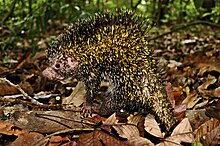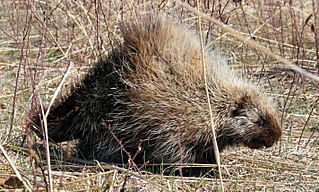
Porcupines are large rodents with coats of sharp spines, or quills, that protect them against predation. The term covers two families of animals: the Old World porcupines of the family Hystricidae, and the New World porcupines of the family Erethizontidae. Both families belong to the infraorder Hystricognathi within the profoundly diverse order Rodentia and display superficially similar coats of rigid or semi-rigid quills, which are modified hairs composed of keratin. Despite this, the two groups are distinct from one another and are not closely related to each other within the Hystricognathi. The largest species of porcupine is the third-largest living rodent in the world, after the capybara and beaver.

The New World porcupines, family Erethizontidae, are large arboreal rodents, distinguished by their spiny coverings from which they take their name. They inhabit forests and wooded regions across North America, and into northern South America. Although both the New World and Old World porcupine families belong to the Hystricognathi branch of the vast order Rodentia, they are quite different and are not closely related.
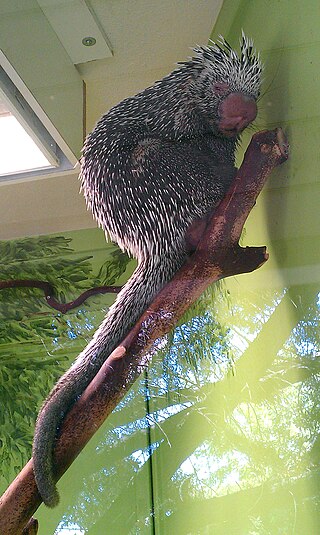
The Brazilian porcupine is a porcupine found in Brazil, Argentina, Uruguay, Colombia, Venezuela, Guyana, French Guiana, Peru, Paraguay, Suriname, Bolivia and Trinidad, with a single record from Ecuador. It inhabits tropical forests at elevations up to 1500 m.

The silver pheasant is a species of pheasant found in forests, mainly in mountains, of mainland Southeast Asia and eastern and southern China. It is introduced on Victoria Island in Nahuel Huapi Lake, Neuquén, Argentina and on Vancouver Island, Canada. The male is black and white, while the female is mainly brown. Both sexes have a bare red face and red legs. It is common in aviculture, and overall also remains common in the wild, but some of its subspecies are rare and threatened.

The prehensile-tailed porcupines or coendous are found in Central and South America. Two other formerly recognized Neotropical tree porcupine genera, Echinoprocta and Sphiggurus, have been subsumed into Coendou, since Sphiggurus was shown by genetic studies to be polyphyletic, while Echinoprocta nested within Coendou.
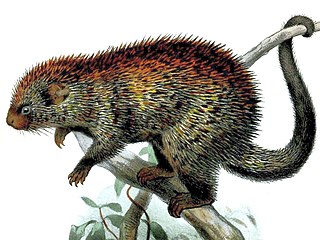
The Paraguaian hairy dwarf porcupine is a porcupine species from the family Erethizontidae. It is found in Argentina, Brazil, Paraguay and Uruguay.

The black-tailed hairy dwarf porcupine is a porcupine species from the family Erethizontidae. It is found in Brazil, Colombia, Ecuador, French Guiana, Guyana, Suriname and Venezuela.
The Bahia porcupine, is a New World porcupine species in the family Erethizontidae endemic to the Atlantic Forest of southeastern Brazil. It was formerly sometimes assigned to Sphiggurus, a genus no longer recognized since genetic studies showed it to be polyphyletic. Sphiggurus pallidus, formerly considered a separate species but known from two young specimens only, is a synonym of this species.
Roosmalen's dwarf porcupine is a porcupine species from the New World porcupine family likely endemic to northern Brazil. Only three specimens were known at the time, and only one had a collection locality. It is named for Marc van Roosmalen and his son Tomas, whose collections from the middle Madeira included the first known specimens. It was soon assigned to the genus Sphiggurus, although this genus was not recognized by the authors. Genetic studies in 2013 have since showed Sphiggurus to be polyphyletic. Nonetheless it is commonly classified as Sphiggurus roosmalenorum. Coendou roosmalenorum may be misspelled due to a conflicting basionym combination.

The bicolored-spined porcupine is a species of nocturnal and arboreal rodent in the family Erethizontidae. It is found in Bolivia, Colombia, Ecuador, and Peru.

The stump-tailed porcupine is a species of rodent in the family Erethizontidae. It is found mainly in Colombia, with a few records from Ecuador.
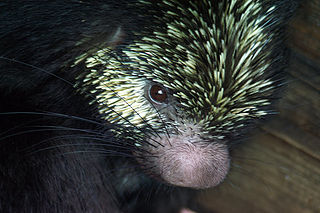
The Mexican hairy dwarf porcupine or Mexican tree porcupine is a species of rodent in the family Erethizontidae. It is found in Costa Rica, El Salvador, Guatemala, Honduras, Panama, Mexico, Nicaragua and Belize.

The brown hairy dwarf porcupine is a species of rodent in the family Erethizontidae. Found in the Andes in Colombia and Venezuela, its natural habitat is subtropical or tropical moist lowland forests. It is not easy to study as it is only known from a few specimens and wasn't recorded from 1925 until the 2000s. The porcupine is nocturnal and arboreal, feeding on leaves, shoots, and fruits. Habitat loss severely threatens it and it may even be extinct. Formerly listed as vulnerable, it is now designated data deficient. It is not known from any protected areas or conservation measures.

The streaked dwarf porcupine is a porcupine species in the family Erethizontidae. It is known from the lowlands of eastern Ecuador, and may be present in Peru as well. It appears to be nocturnal and arboreal in its habits.
The frosted hairy dwarf porcupine is a porcupine species in the family Erethizontidae from Colombia and northern and eastern Venezuela. It was formerly sometimes assigned to Sphiggurus, a genus no longer recognized since genetic studies showed it to be polyphyletic. The species lives in lowland tropical rainforest and cloud forest at elevations from 50 to 2,600 meters. Its karyotype has 2n = 42 and FN = 76. Its closest relative is the brown hairy dwarf porcupine.

The Andean porcupine or Quichua porcupine is a species of rodent in the family Erethizontidae. It is found in the Andes of northern Ecuador and Colombia as well as in Panama. This porcupine is little known, but is probably arboreal, nocturnal and solitary like its relatives. The species is thought to be uncommon to rare and the population decreasing. It is threatened by deforestation, habitat fragmentation and agriculture.

The Santa Marta porcupine is a rodent in the family Erethizontidae. It is known from dry forests on the lower slopes of the Sierra Nevada de Santa Marta and Serranía del Perijá mountains of northern Colombia, at altitudes below 500 and 1100 m, respectively, and intervening lowlands, and may also be present in nearby parts of Venezuela. It has been described as a subspecies of C. prehensilis, although the latter may be a species complex. Its karyotype has 2n = 74, FN = 82.
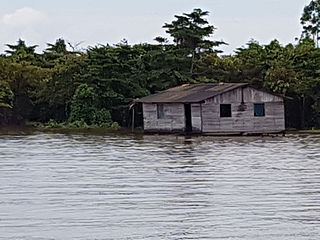
The Gurupa várzea (NT0126) is an ecoregion of seasonally and tidally flooded várzea forest along the Amazon River in the Amazon biome.
Coendou speratus, known locally as coandumirim and commonly as the dwarf porcupine, is small porcupine of the Coendou genus found in northeastern Brazil. This small porcupine has a long tail and a spiny appearance as its dorsal fur is not long. Its dorsal colouring is blackish which contrasts with the brownish tips of its quills. It is distinguished from Coendou nycthemera by its tricolored quills whereas nycthemera is bicoloured.
